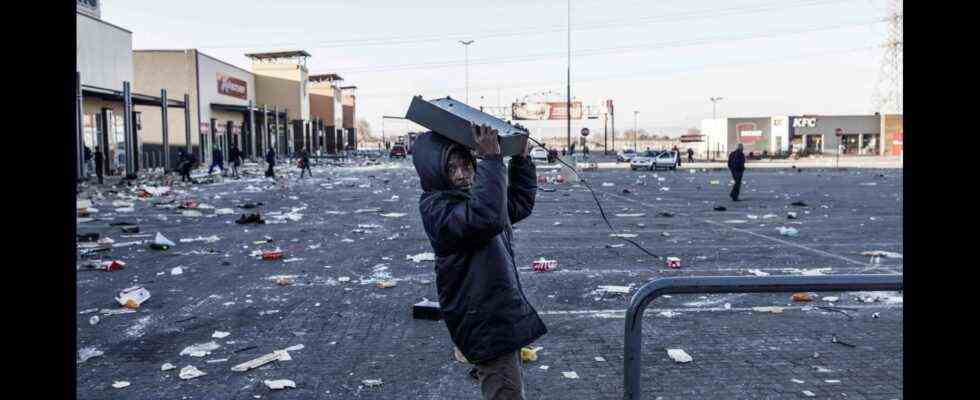Status: 07/14/2021 9:57 p.m.
For a few days, South Africa has been falling into chaos: security forces are overwhelmed, President Ramaphosa stunned. Is the anger that has been pent up for years breaking through with the government – or are supporters of ex-President Zuma the instigators?
From Richard Klug,
ARD studio Johannesburg
Is that what a “failed state” looks like? Many South Africans are currently wondering that. For a few days now, the country on the southern tip of Africa has been sinking into chaos: looting on a scale that no one expected, dozens of deaths and fears that there could be a shortage of food, medicine and gasoline.
Is it just years of pent-up hatred of the government and frustration about the poor living conditions of so many South Africans who are unloading here? Or is it the incitement to rebellion behind it, as some now suspect? Within a few days, the country is in a completely different position than one had suspected weeks ago.
The state has definitely failed with its police force. It had little to oppose the looters, was hopelessly outnumbered and seemed helpless for long stretches. In pictures of the storming of a shopping center in the port city of Durban, there is not a single police officer to be seen.
Other images show police officers desperately trying to arrest looters. They cling to their prey – and some even manage to escape. Other sources report those temporarily arrested who were released shortly afterwards and returned to the other looters to continue searching for loot.
In front of another shopping center in Durban, an employee of the local security service was interviewed by journalists – he too had stolen objects in his arms.
Dozens of deaths and bewilderment
Eventually the army was deployed and the situation calmed down somewhat in many places. But even on Wednesday there was still a few looting. During the clean-up work, horror spread at what was being done.
People walk past the shops looted during protests in Durban, South Africa.
Image: AFP
Dozens of deaths are to be mourned. Many were crushed by their fellow looters in the crowd, some died when a high wall of shelves collapsed above them, others were shot – whether by the police or gangsters, it is often impossible to tell. “It will be a long time before we recover from this,” said eyewitnesses. “The repair work, getting the goods back and hiring new people. Many people will now even more remain unemployed.”
President Cyril Ramaphosa appeared live in front of the cameras. At the bottom of the picture, live images of the looting ran, which the president could also see. “It’s not us,” he said, stunned. “That’s not South Africa”.
Zuma followers made the start
Not only was the extent of the looting and violence surprised many South Africans, but also how quickly it happened. The unrest arose out of a situation of political uncertainty after the former President Jacob Zuma surrendered to the authorities last week and has been in custody ever since.
His supporters demonstrated against his imprisonment and demanded his release. Apparently, many looters noticed that the police seemed overwhelmed, even during the political pro-Zuma demonstrations. Some advanced into this vacuum – countless others followed.
Zuma’s term of office from 2009 to 2018 includes mismanagement and corruption, government failures to an unimaginable extent and clientele economy. The term “state capture” is used for this in South Africa – the capturing of an entire state for the benefit of the interests of the president and a few friends. Cyril Ramaphosa calls this time “nine lost years”. He had finally ousted Zuma from office after a tough and bitter struggle.
Zuma evaded the commission of inquiry
In 2018, a commission of inquiry was set up – chaired by the second highest judge in the country, Raymond Zondo. The Commission should investigate the corruption allegations. Zuma initially appeared sporadically, but soon spoke of politically motivated justice. In November 2020, he left the room during a break from meetings – and never came back.
Zuma and his followers have since fought a political mud battle with Ramaphosa and his followers. Two weeks ago, finally, a clap of thunder: for “disregard of the court” – by which the Zondo Commission is meant – the South African constitutional court sentenced Zuma to 15 months’ imprisonment without parole. Zuma persisted – then, shortly before a final deadline, he turned himself in. The rest of it has been on the screens for days.
In all likelihood it was just a spark on a very short fuse. The majority of South Africans are still poor – for years they have suffered from the failure of the state. The hygiene conditions in the slums are appalling, unemployment is at dizzying heights and the corona pandemic has given the whole thing the last blow. There is hunger again in South Africa.
Theories are also circulating in the country that Zuma supporters incited the looters – Zuma’s former security chief is called. Presumably that was only the motivation for a few looters. Now the country is desperately looking for a solution to end the looting and violence. On state television, a South African interviewed said: “We will pay a high price.”

